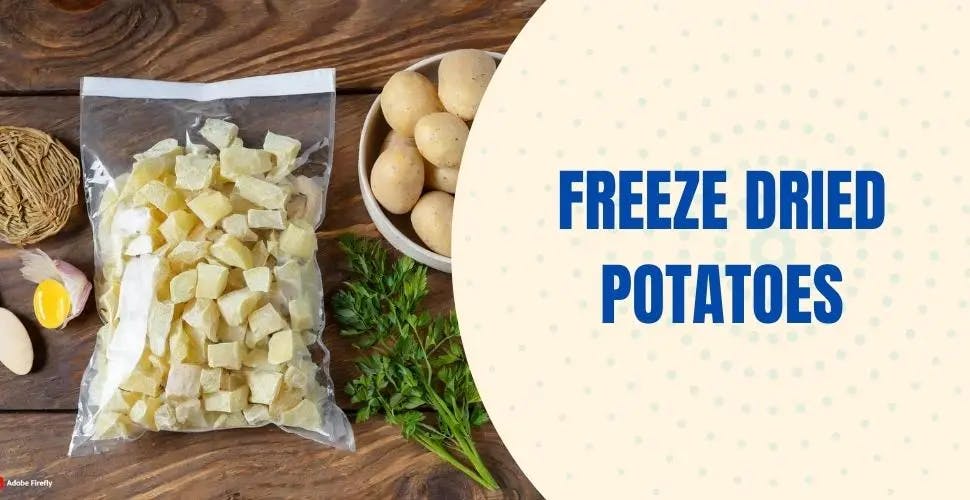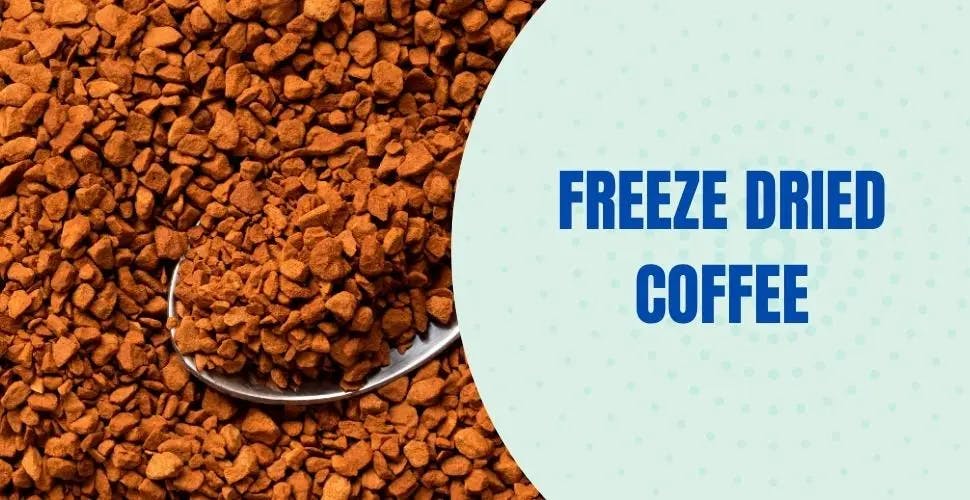Freeze Dried Potatoes: How to Make & Use
 Dr. Tontul
Dr. Tontul- 11 Oct 2023

What Are Freeze Dried Potatoes
Freeze-dried potatoes are potatoes that have undergone a process called freeze-drying. This preservation technique involves freezing the potatoes and then removing the water content through sublimation, where ice transitions directly into water vapor without going through the liquid phase. This process helps retain the shape, taste, and nutritional value of the potatoes while allowing for long-term storage.
Freeze dried potatoes offer numerous advantages over products preserved using other techniques like dehydration:
- Physical quality: Freeze drying provides better physical properties in terms of shrinkage, color and rehydration. In a study, porosity of freeze dried potatoes was much higher than other drying techniques such as vacuum drying, microwave drying, osmotic drying and dehydration.
- Chemical safety: Freeze dried potatoes contains less content of HMF and acrylamide since it is a low temperature process.
- Shelf life: Freeze-drying offers a much longer shelf life, making freeze-dried potatoes an ideal choice for long-term storage, emergency preparation and outdoor use.
- Sensory properties: Freeze drying causes minimal change in taste, flavor and aroma due to the application of low temperatures. Therefore, fresh potatoes can easily be replaced by freeze dried potatoes in almost all recipes.
- Easiness of use: Freeze-dried potatoes do not require any pre-treatment such as washing, peeling and boiling. This reduces the preparation time of potato-based recipes. It can also be used in many different formulations as seen later in this guide.
- Convenience: Freeze-dried potatoes are lightweight, easy to store, and convenient to use. They don't require refrigeration and can be rehydrated quickly by adding water, making them a convenient option for both home and outdoor cooking. In a study pasting properties of freeze dried samples were found to be much higher than dehydrated potatoes. It means that freeze-dried potato powder provided higher viscosity at the same concentration.
How to Make Freeze Dried Potatoes
Supplies needed
For production of a freeze dried potatoes you will need a bunch of supplies are needed.
- Freeze dryer
- Freezer
- Pots
- Cutting board
- Knife
- Colander
- Trays
- Parchment paper
- Mylar bags or mason jars
- Oxygen absorbers
- Cutting board (for slicing)
- Blender (for pureeing)
Step 1: Raw Material Selection
The most important step in achieving a good quality end product is to use high-quality raw materials. Therefore, choose high quality, fully ripe and unsprouted potatoes.
If you plan to use freeze-dried potatoes in the production of various dishes, I recommend choosing a starchy variety.
Step 2: Washing, Peeling and Cutting
Potatoes need to be washed thoroughly because they grow in the ground. For this purpose, wash the potatoes thoroughly under running water.
Then, depending on your preference, remove the skin from the potatoes with a peeler.
If you are going to dry them in slices or cubes, cut the potatoes according to your preference. If you are drying them as mashed, you can cut the potatoes smaller to shorten the blanching time.
Step 3. Blanching and Mashing
The main aim of the blanching is to inactivate the enzymes in potatoes. If not blanched, the enzyme, polyphenol oxidase, present in potatoes cause browning during freeze drying. Therefore, blanching is a must for freeze drying of potatoes. In addition to enzyme inactivation, blanching significantly increase the rehydration capacity of the freeze dried potatoes.
The blanching process can take between 1 and 15 minutes depending on the size of the potatoes. Thin slices can be blanched for one minute, while large pieces or whole potatoes need longer periods such as 15 minutes.
Blanched potatoes become soft and suitable for mashing. If you are aiming for potato powder or flakes, mashed potatoes are your best option. To do this, use a potato masher to ensure that the potatoes are completely mashed.
Step 4: Freezing
After cooling, put potato slices, cubes or purees on trays lined with parchment paper, which simplifies cleanup. Overlapping the potatoes is acceptable, but pay attention to your freeze dryer's capacity. Nonetheless, spreading them out as much as possible on the tray will enhance drying performance. For mashed potatoes adjust the spread thickness about 0.2 inches (5 mm).
The freezing step can be executed in a freeze dryer or using an external freezer. When utilizing an external freezer, put the trays inside of the freezer and wait between 2-8 hours until the products are thoroughly frozen.
Step 5: Freeze Drying
For pre-frozen mangoes, initiate your freeze dryer 30 minutes before commencing the process.
First, close the drain valve! Select the properties of your raw material (pre-frozen or unfrozen) in the dryer software you are employing. The software will provide guidance, and the dryer will initiate.
When the temperature descends to 32ºF (0ºC), the software will prompt you to place the trays. Insert the trays and select to proceed with the process. Generally, drying will conclude within 20-24 hours.
Inspect the products upon completion of drying. To do so, take the thickest items, cut them in half, and check for coldness or moisture in the center. If present, extend the drying process by a few hours; if not, stop.
Step 6: Packaging and Storage
Package the freeze-dried potatoes in airtight bags, vacuum-sealed containers, or other suitable packaging materials to maintain their freshness and prevent moisture reabsorption.
Label the packages with the date of freeze-drying and any other relevant information.
Store the freeze-dried potatoes in a cool, dry place away from direct sunlight. They can remain edible for an extended period, from several years to 3 decades, if stored properly.
How Long Do Freeze Dried Potatoes Last
Freeze dried potatoes have a a significantly extended shelf life compared to dehydrated counterparts. When appropriately stored in an airtight container, freeze dried potatoes can remain viable for up to 25-30 years.
Once the packaging is opened and the contents are exposed to air and moisture, the shelf life decreases. However, properly resealed and stored freeze-dried potatoes can still last quite a long time.
After opening, freeze dried potatoes are more susceptible to environmental conditions due to their unique microstructure. Particularly in humid environments, they rapidly absorb moisture, leading to a soft texture. This process also accelerates chemical degradation reactions. Therefore, it's best to use within a shorter timeframe.
Nutritional Facts of Freeze Dried Potatoes
Freeze dried potato is rich in starch. According to a scientific study, starch content was determined as 72.6% for blanched freeze-dried potatoes. Moreover 100 g of freeze dried potato contained 104.6 mg of vitamin C which is slightly higher than recommended daily intake.
How To Rehydrate Freeze Dried Potatoes
Rehydrating freeze-dried potatoes is a simple process that restores them to their original texture and taste, making them suitable for use in a variety of dishes. Here's a step-by-step guide on how to rehydrate freeze-dried potatoes:
-
Begin by heating liquid to a near-boiling temperature. You can use water, milk, soaps or bone broth to rehydrate the freeze-dried potatoes. The liquid you choose will impart flavor to the potatoes, so choose according to your recipe and taste preferences.
-
Transfer the desired amount of freeze-dried potatoes to a heatproof bowl. The quantity will depend on your recipe and the number of servings you intend to make.
-
Carefully pour the liquid over the freeze-dried potatoes, ensuring they are completely submerged. The ratio of water to potatoes can vary, but usually freeze-dried potatoes can take up to 6 times the liquid.
-
Let the freeze-dried potatoes soak in the hot liquid for about 10 to 15 minutes. During this time, the potatoes will absorb the liquid and begin to rehydrate.
-
Gently stir the mixture occasionally to ensure even rehydration. Check the consistency of the potatoes as they rehydrate. If they are still too firm, allow them to soak for a few more minutes.
-
After the potatoes have fully rehydrated and reached the desired texture, you can drain any excess liquid if needed. This is especially useful if you plan to use the potatoes in recipes where you don't want excess moisture.
-
The rehydrated potatoes are now ready to be used in soups, stews, casseroles, or any other dish that calls for potatoes. Incorporate them as you would with fresh potatoes, adjusting seasoning and flavors as needed.
Rehydrated freeze-dried potatoes maintain their nutritional value and can be used just like fresh potatoes in a wide range of culinary applications. Always adjust the rehydration time and liquid amount based on your specific recipe and desired potato texture.
How to Use Freeze Dried Potatoes
Freeze-dried potatoes are a convenient and versatile ingredient that can be rehydrated and used in a variety of dishes. Here's how you can use freeze-dried potatoes:
Rehydrating Freeze-Dried Potatoes: Place the desired amount of freeze-dried potatoes in a bowl. Cover the potatoes with hot water, ensuring they are fully submerged.
Let them soak for about 10-15 minutes, or as directed on the packaging, until they are soft and plump. Drain any excess water and pat the potatoes dry with a paper towel before using.
In Soups and Stews: Rehydrate the freeze-dried potatoes as instructed above. Add them to soups, stews, or chowders to enhance flavor and add a hearty texture. They can provide substance and thickness to the dish.
In Casseroles and Pot Pies: Rehydrate the freeze-dried potatoes and incorporate them into your favorite casserole or pot pie recipes. They add a potato element and absorb the flavors of the dish.
As a Side Dish: After rehydrating, sauté or roast the potatoes with your preferred seasonings, such as garlic, herbs, or spices, for a tasty side dish.
In Breakfast Dishes: Rehydrate the potatoes and use them to make hash browns or breakfast burrito fillings.
In Salads: Rehydrate the potatoes and toss them into salads for added texture and nutrition. They work well in mixed green salads.
In Pasta Dishes: Incorporate rehydrated potatoes into pasta dishes like creamy pasta, pasta salads, or as a filling for stuffed pasta.
In Baked Goods: Grind rehydrated potatoes into a powder and use them as an ingredient in baked goods like bread, rolls, or muffins for added moisture and flavor.
As a Topping: Rehydrate and use freeze-dried potatoes as a topping for shepherd's pie or as a crunchy garnish for soups and salads.
Remember to adjust the rehydration time and cooking method based on your specific recipe and taste preferences. Freeze-dried potatoes are a convenient option for adding a potato element to various dishes without the need for fresh potatoes.
Customer Reviews on Freeze Dried Potatoes
These comments are chosen from different products on different websites.
- These are very tasteful and when reconstituted, I use in stews, soups, fried with onions, or any other variation. Highly Recommended!
- Great taste. I have been using these potatoes in my homemade potato soup, wife & I both love the taste. Will be using these all of the time, much easier than peeling & slicing/dicing potato's.
Frequently Asked Questions (FAQ)
Can potatoes be freeze-dried?
Yes, potatoes can be freeze-dried. Freeze-drying is a preservation method that involves removing moisture from the potatoes, allowing them to be stored for extended periods without spoilage.
Are freeze-dried potatoes good for you?
Yes, freeze-dried potatoes can be a good source of nutrition. The freeze-drying process retains most of the original nutrients, including vitamins, minerals, and fiber, making them a convenient and nutritious option for consumption.
How to make freeze-dried potato chips?
Making freeze-dried potato chips involves slicing potatoes thinly, blanching them to preserve color and nutrients, freezing them, and then placing them in a freeze-dryer until all the moisture is removed. The resulting freeze-dried slices can be enjoyed as crispy potato chips.
Are freeze-dried potatoes better than dehydrated?
Both freeze-dried and dehydrated potatoes have their advantages. Freeze-drying tends to retain the potato's original texture, taste, and nutritional value better than traditional dehydration, which involves using heat. However, the choice between the two depends on personal preference and the intended use in recipes.
Do I need to cook potatoes before freeze-drying?
Blanching or partially cooking the potatoes before freeze-drying is a common step. Blanching helps preserve the color and nutritional content of the potatoes and provides better rehydrability.
Are freeze dried potatoes keto?
Freeze Dried potatoes is not keto-friendly because it is high in starcb. It may kick you out of ketosis even with a small serving size.


